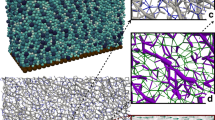Abstract
Secondary cone-type crushing machines are an important part of the aggregate production process. These devices process roughly crushed material into aggregate of greater consistency and homogeneity. We apply a continuum model for granular materials (Jop et al., Nature 441:727–730, 2006) to flows of granular material in representative two-dimensional channels, applying a cyclic applied crushing stress in lieu of a moving boundary. Using finite element methods, we solve a sequence of quasi-steady fluid problems within the framework of a pressure-dependent particle size problem in time. Upon approximating output quantity and particle size, we adjust the frequency and strength of the crushing stroke to assess their impacts on the output.
























Similar content being viewed by others
References
Jop P, Forterre Y, Pouliquen O (2006) A consitutive law for dense granular flows. Nature 441:727–730
Evertsson CM (1999) Modelling of flow in cone crushers. Miner Eng 12(12):1479–1499
Evertsson CM (2000) Cone crusher performance. PhD Thesis, Department of Machine and Vehicle Design, Chalmers University of Technology
Broadbent SR, Callcott TG (1956) A new analysis of coal breakage processes. J Inst Fuel 29:524–539
Lindqvist M, Evertsson CM (2003) Prediction of worn geometry in cone crushers. Miner Eng 16(12):1355–1361
Lindqvist M, Evertsson CM (2004) Improved flow- and pressure model for cone crushers. Miner Eng 17(11–12):1217–1225
Bengtsson M, Evertsson CM (2006) An empirical model for predicting flakiness in cone crushers. J Miner Process 79:49–60
Lindqvist M, Evertsson CM (2006) Development of wear model for cone crushers. Wear 261:435–442
Lindqvist M, Evertsson M, Chenje T, Radziszewski P (2006) Influence of particle size on wear rate in compressive crushing. Miner Eng 19:1328–1335
Hulthén E, Evertsson CM (2009) Algorithm for dynamics cone crusher control. Miner Eng 22:296–303
Lee E, Evertsson CM (2011) A comparative study between cone crushers and theoretically optimal crushing sequences. Miner Eng 24(3–4):188–194
Huang D, Fan X, Wu D, Yao F (2007) Multi-objective planning of cone crusher chamber, output and size reduction. Miner Eng 20:163–172
Huang D, Fan X, Wu D, Yao F (2008) Research on cone crusher chamber geometry. China Mech Eng 19(17):2041–2045,2049
Dong G, Fan X, Huang D (2009) Analysis and optimization of cone crusher performance. Miner Eng 22(12):1091–1093
Dong G, Huang D, Fan X (2009) Cone crusher chamber optimization using multiple constraints. Int J Miner Process 93:204–208
Goldhirsch I (2003) Rapid granular flows. Annu Rev Fluid Mech 35:267–293
Nedderman RM (1992) Statics and kinematics of granular materials. Cambridge University Press, Cambridge
Janssen HA (1895) Versuche über getreidedruck in silozellen. Zeitschr. d. Vereines deutscher Ingenieure 39:1045
Sperl M (2006) Experiments on corn pressure in silo cells—translation and comment of Janssen’s paper from 1895. Granul Matter 8:59–65
Boutreux T, Raphaël E, de Gennes PG (1997) Propagation of a pressure step in a granular material: the role of wall friction. Phys Rev E 55(5):5759–5773
de Gennes PG (1999) Granular matter: a tentative view. Rev Mod Phys 71(2):S374–S382
Ertaş D, Halsey TC (2002) Granular gravitational collapse and chute flow. Europhys Lett 60(6):931–937
Dean EJ, Glowinski R, Guidoboni G (2007) On the numerical simulation of Bingham visco-plastic flow: old and new results. J Non-Newton Fluid Mech 142:36–62
Papanastasiou TC (1987) Flows of materials with yield. J Rheol 31(5):385–404
Papanastasiou TC, Boudouvis AG (1997) Flows of viscoplastic materials: models and computations. Comput Struct 64(1–4):677–694
Kinderlehrer D (1978) Variational inequalities and free boundary problems. Bull Am Math Soc 84(1):7–26
Huilgol RR (2002) Variational inequalities in the flows of yield stress fluids including inertia: theory and applications. Phys Fluids 14(3):1269–1283
Domnik B, Pudasaini SP (2012) Full two-dimensional rapid chute flows of simple viscoplastic granular materials with a pressure-dependent dynamic slip-velocity and their numerical solutions. J Non-Newton Fluid Mech 173–174:72–86
Bearman RA, Briggs CA (1998) The active use of crushers to control product requirements. Miner Eng 11(9):849–859
Ide JM (1936) Comparison of statically and dynamically determined Young’s modulus of rocks. Proc Natl Acad Sci 22(2):81–92
Roquet N, Saramito P (2008) An adaptive finite element method for viscoplastic flows in a square pipe with stick-slip at the wall. J Non-Newton Fluid Mech 155:101–115
Rao IJ, Rajagopal KR (1999) The effect of the slip boundary condition on the flow of fluids in a channel. Acta Mech 135:113–126
Gatica GN, Maischak M, Stephan EP (2011) Numerical of a transmission problem with Signorini contact using mixed-FEM and BEM. ESAIM 45:779–802
de Souza Mendes PR, Naccache MF, Varges PR (2007) Flow of viscoplastic liquids through axisymmetric expansions–contractions. J Non-Newton Fluid Mech 142(1–3):207–217
Daouadji A, Hicher P-Y (2009) An enhanced constitutive model for crushable granular materials. Int J Numer Anal Methods Geomech 34:555–580
Bika DG, Gentzler M, Michaels JN (2001) Mechanical properties of agglomerates. Powder Technol 117:98–112
Shipway PH, Hutchings IM (1993) Attrition of brittle spheres by fracture under compressionand impact loading. Powder Technol 26:23–30
Couroyer C, Ning Z, Ghadiri M, Brunard N, Kolenda F, Bortzmeyer D, Laval P (1999) Breakage of macroporous alumina beads under compressive loading: simulation and experimental validation. Powder Technol 105:57–65
Nitsche J (1971) Über ein Variationsprinzip zur Lösung von Dirichlet Problemen bei Verwendung von Teilräumen, die keinen Randbedingungen unterworfen sind. Abhandlungen aus dem Mathematischen Seminar der Universitt Hamburg 36:9–15
Acknowledgments
We would like to thank the EPSRC and Terex Pegson, especially Ian Boast and Tim Cummings of Terex Pegson, for their promotion and sponsorship of this CASE project. We also thank the the University of Nottingham for their wonderful staff and facilities.
Author information
Authors and Affiliations
Corresponding author
Rights and permissions
About this article
Cite this article
Bain, O., Billingham, J., Houston, P. et al. Flows of granular material in two-dimensional channels. J Eng Math 98, 49–70 (2016). https://doi.org/10.1007/s10665-015-9810-1
Received:
Accepted:
Published:
Issue Date:
DOI: https://doi.org/10.1007/s10665-015-9810-1




